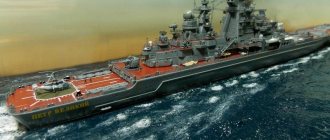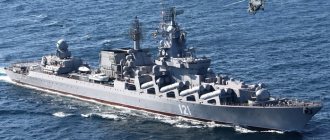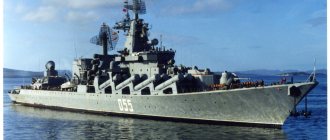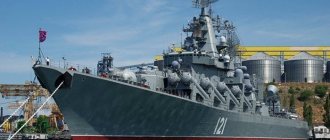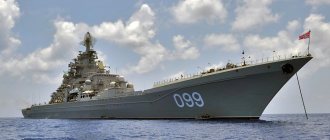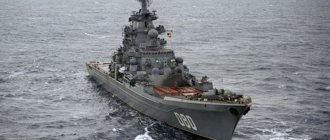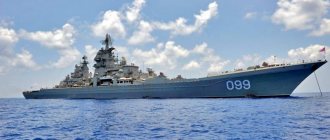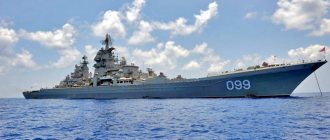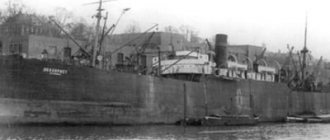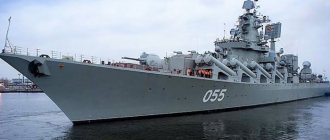TARKR "Peter the Great"
The heavy nuclear-powered missile cruiser (TARKR) "Peter the Great" is the largest and currently the only ship of this class in the world. It is designed to destroy large surface targets, protect naval formations from attacks from the air and from enemy submarines, having the ability to operate in any sea and ocean area of the planet.
As part of the Russian Navy, Peter the Great is the flagship of the Northern Fleet and the second largest ship, second only to the heavy aircraft-carrying cruiser (TAKR) Admiral Kuznetsov. Possessing powerful and quite effective weapons, albeit still of Soviet design, “Peter the Great”, to this day, represents a real threat to naval convoys and even carrier strike groups of a potential enemy.
The history of the appearance of TARKR "Peter the Great"
In the mid-1960s, the Soviet Union began designing a new type of surface combat ship with a virtually unlimited range.
Initially, it was planned to create an anti-submarine ship with a displacement of about 8 thousand tons with a nuclear power plant. However, after the appearance in the late 1960s of US Navy submarines with intercontinental missiles and nuclear power plants, it was necessary to create a larger multi-purpose cruiser compared to the previously designed one.
As a result, design work began on Project 1144, the goal of which was to create a heavy nuclear-powered missile cruiser (TARK). The project, called "Orlan", was completed in 1972. Initially, Project 1444 “Orlan” was supposed to build seven ships with a nuclear power plant (NPP). Since 1973, cruisers of this type were laid down and built at the Baltic Shipyard: “Kirov”, “Frunze” and “Kalinin”, and since 1992 they began to be called “Admiral Ushakov”, “Admiral Lazarev” and “Admiral Nakhimov”, respectively.
The shipyard began construction of the next ship, which was destined to become the last in the TARKR series, in April 1986. By the time of its construction, the project had been modernized, receiving the designation 1444.2. The design of the ships did not change; compared to its predecessors, each new cruiser was equipped with more modern weapons systems. When laid down, the ship was called “Kuibyshev”, then for a short time it bore the name “Yuri Andropov”. Ultimately, the most powerful cruiser in the world, launched in 1989, was finally completed after the collapse of the USSR.
10 years after the start of construction, TARKR was able to begin sea trials, conducting them in the harsh conditions of the Arctic. After their completion, the nuclear-powered cruiser, which received the name “Peter the Great” in 1992, was transferred to the Northern Fleet of the Russian Navy, receiving hull number 099. The beginning of the cruiser’s combat service in the Russian fleet dates back to the moment the naval flag was raised on it, which took place on April 18, 1998 .
By that time, the first two cruisers of the Orlan project were decommissioned in the 1990s, and Admiral Nakhimov was mothballed for many years. Since 2013, work has begun on this cruiser on its deep modernization with the aim of re-equipping it with more modern types of weapons, but this process cannot be expected to be completed before 2022.
"Yury Dolgoruky"
The submarine is capable of diving to a depth of 450 meters and firing with the help of Bulava ballistic missiles, which it has in its arsenal. Having
figured out which cruiser is the largest in Russia, we should dwell on the characteristics of the largest submarine. This is the nuclear submarine “Yuri Dolgoruky”, the length of which is 170 meters.
K-535 “Yuri Dolgoruky” is part of the Red Banner Northern Fleet and is registered in the Murmansk region.
It entered service with the fleet in 1995 and is still in use today.
Warship design
TARKR "Peter the Great" at the construction stage, unlike its nuclear-powered predecessor cruisers with almost similar characteristics, received increased autonomy (up to 60 days) and an unlimited cruising range. The cruiser's hull has 6 decks, and the superstructure has 8 tiers. In order to increase the survivability of the ship, the most important parts of its hull have armor with a thickness of 50 to 100 mm.
The total number of premises intended for the crew's living activities is about 1,600, including 140 cabins and 30 cockpits, 3 saunas, 15 showers, and a gym. The regular crew size is 1035 people, including 105 officers, 130 midshipmen, 800 sailors. 18 people are flight personnel.
The cruiser's main power plant is equipped with two fast neutron nuclear reactors with a thermal power of 300 MW each and two auxiliary oil steam boilers, which are designed to both increase the overall power of the ship's power plant and provide it with the ability to sail up to 1000 miles without the use of nuclear power plants. The ship's power system also includes 8 steam and gas generators, 4 power plants with a total capacity of 18 MW, and 2 turbines with 75 thousand horsepower.
The cruiser's two propeller shafts rotate along a five-blade propeller.
Combat use
The Peter the Great TARKR did not have to participate in combat operations that required direct engagements with enemy attack ships. The main content of his service in the Russian Navy was activities related to combat training. The ship took part in a variety of exercises many times and made several long-distance voyages. The cruiser "Peter the Great" visited all the oceans of the Earth, traveled more than 170 thousand nautical miles, and has completed a circumnavigation.
The cruiser "Peter the Great" on a long voyage
However, the ship had the opportunity to take part in several quite important operations that went down in the history of the Russian navy.
In August 2000, the cruiser discovered the site of the sinking of the Kursk nuclear submarine and then patrolled the area during the operation to raise the sunken submarine.
In February 2009, the Peter the Great, during one of its long voyages, was able to detain three ships of Somali pirates in the Gulf of Aden, although the use of a heavy missile cruiser in this case was caused only by a special coincidence of circumstances.
In July 2012, the TARKR "Peter the Great" became the first ship in the history of the modern Russian Navy to be awarded the Order of Nakhimov.
From October 2016 to February 2022, "Peter the Great" carried out long-range missions in the Northeast Atlantic and Mediterranean Sea, ensuring the combat stability of the Northern Fleet carrier group, which for the first time took part in a combat operation to combat international terrorism in Syria with the use of attack aircraft from a Russian aircraft carrier against militant targets.
In the near future, there is reason to expect that the further service of the Peter the Great will be extended for a very long period after a deep modernization, similar to the one currently being carried out on the same type cruiser Admiral Nakhimov.
Specifications
Scheme of TARKR "Peter the Great"
The main performance characteristics of Peter the Great include:
- Length - 250.1 m;
- Width at the waterline - 25 m;
- Height from the level of the main plane - 59 m;
- Draft - 10.3 m;
- Standard displacement - 23,750 tons;
- Total displacement - 25,860 tons;
- Maximum speed is 32 knots.
Features of the cruiser's strike and defensive weapons
Anti-aircraft, strike, and anti-submarine weapons allow the Peter the Great TARKR to solve almost any combat mission. In terms of the totality of its strike missile power, the flagship of the Russian Northern Fleet is superior to any of the cruisers in the world, including the American Ticonderoga-class missile cruisers, which, despite their impressive number of cruise missiles, have a rather “narrow specialization.”
The Peter the Great's superstructures carry many radars and antennas for early warning systems. In particular, the detection of air targets is entrusted to three radar stations for various purposes, among which there is a system for detecting low-flying targets. It is the absence of such a specialized radar that makes the American Aegis system vulnerable.
In general, the flagship of the Russian Northern Fleet, Peter the Great, has reliable protection against a surprise attack, capable of effectively responding to any missile threat from the air in 8-24 seconds, and to an underwater attack in 15 seconds. The cruiser's own electronic warfare systems and guidance systems also significantly surpass their American counterparts in their characteristics.
Firing training from the heavy nuclear-powered missile cruiser "Peter the Great"
Crew composition and conditions of service
The cruiser "Peter the Great" is the largest non-aircraft carrier ship in the world, performing the tasks of eliminating surface targets, defending fleet facilities from underwater and air attacks, and destroying enemy aircraft. There are 610 people on the ship: sailors, foremen, officers and pilots. The team occupies single and double officer cabins and sailor quarters (8-30 people each). There are 15 shower rooms, a bathhouse with a sauna and a swimming pool for the entire crew.
Navy Day
Medical care for the crew is carried out in a two-story block, where there are infirmaries, isolation wards, a pharmacy and special doctors' offices. There is a gym equipped with exercise equipment, a relaxation room with a billiard table and a grand piano. The cruiser has its own television studio and more than 10 televisions in the cockpits and cabins.
Trip to the Arctic TARKR "Peter the Great"
The nuclear-powered missile cruiser "Peter the Great" is part of military unit 09906, stationed in Severomorsk, Murmansk region. Letters are sent to the following address: 184606, Murmansk region, Severomorsk, military unit 09906 TARKr Peter the Great, unit number (ask the sailor), full name of the employee.
Cruiser "Peter the Great"
Parcels are sent to the post office address: 184606, Murmansk region, Severomorsk-6, st. Severnaya, 4-a. The packages are then delivered to the ship. Regarding the oath, eyewitnesses note the following points:
- For the trip you need two passes - to the closed city of Severomorsk and to the ship.
- The recruit writes a report addressed to the commander, in which he indicates the passport details of his parents/official spouse for the pass. You can send copies of documents to the unit’s email (the employee will tell you the address).
- The lists are transferred to the checkpoint and issued upon entering the ZATO.
- Entrance to the ship is through a separate checkpoint. Lists of visitors are also transferred to it.
On board the nuclear cruiser "Peter the Great"
On leave after taking the oath, you are allowed to leave only with your parents or official wife. According to reviews of those who visited the cruiser "Peter the Great", dismissal is given for two days on the security of a passport.
The main armament of the cruiser
20 supersonic anti-ship missiles P-700 "Granit"
High-precision anti-ship cruise missiles "Granit" on the "Peter the Great" are located in 20 SM-233 launchers under the upper deck. Rocket length - 10 m, caliber - 0.85 m, launch weight - 7 tons. The warhead is a monoblock in nuclear (500 kilotons) or conventional (750 kg of explosive) ammunition, and can also carry a volumetric explosion fuel-air warhead. Firing range - up to 625 km, flight speed - up to 2.5 M (at altitude) and up to 1.5 M at the surface of the water.
These missiles have an integrated-autonomous control system: their flight is coordinated by the “leader”, if he is defeated by missile defense means, his functions are automatically transferred to the new leader. In combination with radio interference and decoys, a full-scale salvo of Granites from the Peter the Great becomes almost irresistible, with at least serious damage to the main target.
Anti-aircraft systems
| Characteristics | S-300 "Fort" | S-300 "Fort-M" | SAM "Dagger" | ZRAK "Dirk" |
| Number of PU | 6 | 6 | 16 | 6x8 |
| Missile stock | 48 | 48 | 128 | 144 |
| Range, km | Up to 150 | Up to 200 | 1,5-12 | 1,5-8 |
| Target engagement altitude, km | 0,025-25 | 0,01-25 | 0,01-6 | 0,005-3,5 |
| Warhead mass, kg | 145 | 180 | 15 | 9 |
Anti-aircraft missile systems (SAM) S-300 “Fort” and “Fort-M” are respectively located in the stern and bow of the cruiser “Peter the Great”.
Anti-aircraft weapons
The artillery component of the anti-aircraft weapons includes 30-mm automatic six-barreled AK-630 mounts as part of the Kortik air defense system (two in each launcher) with a total ammunition capacity of 48 thousand shells. The total rate of fire of these installations is about 10 thousand rounds per minute, the parameters for effective firing at air targets are 500-4000 m in range and 5-3000 m in altitude. Muzzle covers are placed on the barrel blocks to protect the installation and containers with missiles from powder gases. The first-stage ammunition is placed in two drums of 500 rounds of ammunition next to the barrel blocks; the machine guns are powered not by a belt, but by a screw (linkless).
Artillery part of the weapon
The basis of the Peter the Great's artillery armament is the twin 130-mm AK-130 multi-purpose artillery mount, capable of hitting coastal, sea and air targets. The barrels have a length of 70 calibers and a maximum elevation angle of 85 degrees, which ensures a gun range of up to 25 km. Rate of fire - from 20 to 90 rounds per minute. The mass of explosives contained in high-explosive fragmentation shells with various types of fuses is 3.56 kg. The ammunition prepared for firing includes 180 shells, and their total ammunition on the ship is 840 shells.
The guns can operate in fully automatic control and aiming mode, as well as in manual mode. The MP-184 fire control system allows for simultaneous tracking and firing of two targets.
"Peter the Great" has reliable protection against surprise attacks from the air and from under water
Anti-submarine weapons
The cruiser's anti-submarine weapons are equipped with the Vodopad-NK anti-submarine missile system, the Udav-1 anti-torpedo system, RBU-1000 missile and bomb launchers and Ka-27PL helicopters.
The Vodopad-NK anti-submarine missile system has 20 anti-submarine missiles capable of operating at a range of up to 50 km and carrying either a nuclear charge or a small-sized homing torpedo UGMT-1, with a speed of up to 41 knots. Firing is carried out from 10 launchers (PU) - 533 mm caliber missile and torpedo tubes. After this, the missile launches into the air from the water surface and delivers its warhead to the target area.
The Udav-1 anti-torpedo system is equipped with 40 missiles for firing from 10 RBU launchers (rocket-propelled bomb launchers) with a caliber of 300 mm, capable of hitting enemy torpedoes and submarines at a distance of up to 3 km. The cruiser Admiral Kuznetsov has a similar system.
The Smerch-3 anti-torpedo protection system, which includes:
- two six-tube remotely guided anti-submarine missile launchers RBU-1000 (ammunition capacity of 102 missiles with a range of up to 1 km and a charge weight of 55 kg);
- charger;
- RSL-10 depth charges;
- the “Storm” system, which controls the fire of up to four RBUs.
Two Ka-27PL helicopters are also designed for anti-submarine protection, equipped with anti-submarine equipment: search radar, sonobuoys, acoustic system and magnetic anomaly detectors. The third of the Ka-27 cruisers is equipped as a search and rescue helicopter. But all three aircraft can be armed with anti-submarine torpedoes, bombs, mines, and anti-ship missiles.
Cruiser "Peter the Great"
Military sailors told why the cruiser "Peter the Great" is called a submarine killer
"Boat Killer"
Three hours from Moscow to Severomorsk on board the An-148 in a casual conversation with colleagues flew by almost unnoticed. There were enough journalists who wanted to capture the strength and power of the atomic giant. About 60 representatives of the world's largest news agencies and television companies were invited to the press landing at the main base of the Northern Fleet.
The Kola Peninsula greeted us, arriving from the blooming Moscow May, with rain and snow, and already upon leaving the plane I regretted that I had not yet changed my sneakers to something more suitable for the weather. May in the Arctic was strikingly different from the capital.
It was simply impossible not to notice the ship "Peter the Great". This steel giant towers like a gray block above other ships moored in the North Sea port. Severe and majestic, matching the Arctic seas.
It is truly not easy for a simple man in the street, far from shipbuilding, to realize that this colossus is the creation of human hands. Just try to imagine a ship almost as tall as a twenty-story building and 250 meters long. Inside there are 49 corridors with a total length of more than 20 kilometers.
The cruiser's powerful nuclear heart allows it to reach a speed of 32 knots, which is 60 km per hour. To understand: the cruiser “Peter the Great” is capable of providing electricity and heat to a city of 150–200 thousand inhabitants.
“The cruiser was laid down in 1986, and initially it was called Yuri Andropov,” said the ship’s officer, Lieutenant Commander Alexander Smirnov. — And in 1992, by decree of President Boris Yeltsin, it was renamed “Peter the Great”.
In 1996, the cruiser passed sea trials and made an inter-naval transition from the Baltic to the main base of the Northern Fleet. And in 1998, the St. Andrew’s flag was raised on the cruiser as a symbol of its belonging to the Russian Navy. The ship's crew numbers more than 730 people and consists exclusively of professionals - contract military personnel.
“Right below us,” the officer gestured to the floor, “there is a hangar that houses three anti-submarine helicopters.” In addition, “Dirk” installations are located on the deck on the starboard and port sides. Also from here we can see the AK-130 double-barreled artillery mount...
HELP "MK"
The Kortik anti-aircraft missile and artillery system ensures the ship's defense against high-precision enemy weapons, including anti-ship and anti-radar missiles, adjustable bombs, airplanes and helicopters, and small ships. Two Kortik air defense systems are located in the bow of the ship, and four others are located in the aft part of the main superstructure.
— How often does a cruiser go to sea?
“On command,” the officer said curtly. — There were five main long-distance trips. In 2008, the ship visited France, South Africa, Libya, Venezuela and India. In total, he spent six months at sea. In 2010 there was a second big military campaign. The ship was transitioning to the Pacific Fleet for joint exercises and in addition visited the ports of France.
Photo: Natalia Gubernatorova
In September 2012, "Peter the Great" carried out the first Arctic reconnaissance to the New Siberian Islands. In 2013, the ship performed tasks in the Mediterranean Sea. The main task is to ensure the safety of the removal of chemical weapons from the Syrian Arab Republic. More than a million tons of chemical weapons were removed.
The next cruise - from 2016 to February 2022 - the ship carried out tasks in the Mediterranean Sea, near Syria, where our air forces participated in the fight against the terrorist group ISIS, which is banned in our country. Naturally, the task was completed successfully.
- What was it?
— In simple terms, in intimidating militants and demonstrating combat power. The management highly appreciated the professionalism of the crew and nominated everyone for awards.
In July 2022, the ship became the flagship at the first major naval parade in modern Russian history. Afterwards, “Peter the Great”, of course, went to sea, but as usual.
— What is the longest voyage of “Peter the Great” and how long can it remain in “autonomy”?
— Seven months is the longest trip. The cruiser's autonomy is not limited. If we talk about restrictions, this concerns food supplies. They are designed for 60 days. But they can be replenished at the port.
— Are there any special traditions on the cruiser?
— Initiation into sailors. But this is not only on our cruiser, it is the same for all beginners. The first time a newly minted fighter goes out to sea, he must drink a glass of sea water...
Almost feeling the taste of salty liquid at these words, I involuntarily winced. This did not go unnoticed by the officer.
- Well, why are you grimacing? - He asked in a more humorous tone, but maintaining a serious expression on his face. — Tradition is tradition. Straight from the lampshade. The water at depth is clean and not scary to drink. Well, if it tastes salty, you’re a naval officer, so you get sea water.
— What do sailors call a cruiser among themselves?
The officer thought for a moment.
- They call it a submarine killer.
"The right way"
We were invited to go to another part of the deck to meet with the commander of the cruiser. Captain 2nd Rank Artem Ponomarev spoke about the history of the flagship cruiser, its purpose and combat equipment. The rank of captain 2nd rank in the “land” version is equivalent to lieutenant colonel. It seemed to me that the rank of admiral would be more suitable for the commander of such a formidable ship. But, apparently, everything is ahead for Artem Ponomarev.
— The cruiser “Peter the Great” can hit large surface targets and protect large naval groups from attacks from the air and enemy submarines. It has an unlimited cruising range. The cruiser is equipped with the Granit anti-ship missile system, as well as the Reef anti-aircraft system, an autonomous ship-based anti-aircraft system. It has three navigation stations, four radio-electronic fire control systems for on-board weapons, helicopter flight controls and a friend-or-foe identification system. In 2013, for the first time in the history of the country's Navy, President Vladimir Putin awarded the cruiser the Order of Nakhimov.
Photo: Natalia Gubernatorova
After the cruiser commander's speech, journalists had some time to ask questions and take photos. I decided to continue the dialogue with Alexander Smirnov.
“Aren’t you bored serving here?”
“We don’t have much time to be bored.” There are many tasks. We serve in three shifts: one at the combat post, two performing other tasks or resting. We have all the conditions for leisure here: two baths, gyms, a library, billiards. Its own medical unit with an infirmary and an operating room.
-Will you show us? — my colleague perked up.
“No,” the officer smiled. — Unfortunately, this is not provided.
— Are these conditions for military personnel on all cruisers or just yours?
- Almost all of them are the same. Depends, of course, on the rank of the ship and dimensions. Everyone copes with a long time away from home differently, so it is necessary to create maximum conditions so that the person feels comfortable and can be distracted. Officers and midshipmen live two people per cabin, sailors live in quarters for about ten people. We even have pets. The cats have moved in. I don’t know where they came from, but they like ship life. They don't leave.
- Cats? - I was surprised. “Do they really say that they feel the storm is approaching?”
“I don’t know what cats feel there,” the officer laughed, “our navigator “feels” everything well.” In general, it happens that you have to take your pet with you from home. Let’s say your family has gone somewhere, and you’re off to sea. So we are not deprived of communication with our smaller brothers here.
— Is the food on the ship tasty? Do you prepare something special for holidays or birthdays?
- Well, of course. There is a festive table and cakes are baked for birthday people. In general, the food is good, tasty and varied. The diet has everything you need, fresh fruits and vegetables. We have five canteens on the cruiser: one for officers, one for midshipmen and three for sailors.
— How did you get into the navy?
— My grandfather served in the Northern Fleet, so I can be said to be a hereditary officer.
- Then tell me, as a hereditary officer, what is the most difficult thing in your service?
- I won’t answer. It seems to me that if you start complaining while completing a task, it means you have chosen the wrong path. I believe that I chose exactly the right path for myself.
- Well, what about separation from family? It's hard. The husband is at sea for six months, the wife is at home.
- Wives are different. Some people understand, some don't. I immediately warned my wife.
- And How? Understood?
“Well, since we’re still together, that means I understand,” the officer smiled.
Our dialogue was interrupted by an invitation to go down to the hall, where the commander of the Northern Fleet, Hero of the Russian Federation, Admiral Alexander Moiseev, spoke to journalists. He spoke about the role of the Northern Fleet in solving problems regarding the defense capability of our country. He especially emphasized that protecting Russia’s national interests in high latitudes is now a priority, since recently there has been an increase in the activity of the armed forces of foreign states in the Arctic zone. According to the admiral, all these actions are “provocative in nature.”
Journalists in Severomorsk were shown the nuclear-powered cruiser "Peter the Great": vivid footage
See photo gallery on the topic
After the commander's speech, all participants in the press tour were invited to the officers' dining room, where we had the opportunity to personally try the menu of military sailors.
It is worth admitting that the officers were not exaggerating at all when they proudly talked about the culinary abilities of the ship's cooks. As they say, the first, second, and compote were all very tasty.
Ahead of us was the second part of the Arctic press tour - Franz Josef Land.
Moscow-Severomorsk-Moscow.
Advantages and disadvantages
The Project 1144 Orlan heavy nuclear missile cruisers did not have and do not have direct analogues abroad. The variety of weapons of the TARKR "Peter the Great" made this ship multi-purpose, although the downside of this situation was its increased complexity in maintenance and, which is also important, the high cost of ensuring combat access to the sea. An important advantage is the high degree of protection of the ship from missile and torpedo attacks.
But at the same time, experts note that even such a powerful ship alone will not be able to fully fight; all its advantages can be most manifested only as part of a strike force. In Soviet times, TARKR were planned as the basis of a naval strike group (KUG), which was quite capable of dealing with even the most powerful enemy carrier strike group. To date, for “Peter the Great” this is only possible after replacing the main weapons systems developed in the USSR with newer ones. Since it must be taken into account that it is almost impossible to ensure the secrecy of the appearance of such a powerful ship in any area of the world's oceans.
Missile cruiser “Moskva”
For the impeccable fulfillment of assigned tasks, he was awarded the Order of Nakhimov in 2016.
Another contender for the title of “the largest ship in the Russian Federation” is the missile cruiser “Moskva”.
This is one of the largest Russian warships, but the largest cruiser in Russia is still Peter the Great.
The length of this ship is almost 187 meters, the width is almost 21 meters. This ship was built by the Nikolaev Shipyard (Ukraine) in the late 80s of the last century, and is still in successful operation, but in 2022 it underwent major repairs. As part of the USSR it bore the name “Slava”, then it was renamed when it became part of the Russian Navy.
